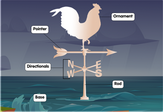Wind vane diagram game quiz online
 Perhaps you’ve noticed farmhouses in films with a rooster-type wind vane, or your own house might have such a device. If you’re curious about how to read a wind vane, we’ve prepared the following diagram to help you. Observing the direction of the wind is one of the most common methods that people use to predict the weather. The wind vane is a very simple tool for such a purpose. As wind blows by, the vane spins and points in the direction from which it blows. For instance, if a wind comes and spins the vane southwest, it means the wind comes from that direction. There are two main parts to a traditional wind vane. On the first end is an arrowhead that turns to point at the wind direction. The second end is typically wider; this helps the instrument catch the breeze. Other types of wind vanes do exist. Many varieties use animals, such as roosters, tigers, or dragons, as a decorative way to point at the direction of the wind. Yet other varieties. You can make use of this
wind vane diagram
to better visualize the different components that make up this everyday meteorological instrument and learn how to use it effectively.
Perhaps you’ve noticed farmhouses in films with a rooster-type wind vane, or your own house might have such a device. If you’re curious about how to read a wind vane, we’ve prepared the following diagram to help you. Observing the direction of the wind is one of the most common methods that people use to predict the weather. The wind vane is a very simple tool for such a purpose. As wind blows by, the vane spins and points in the direction from which it blows. For instance, if a wind comes and spins the vane southwest, it means the wind comes from that direction. There are two main parts to a traditional wind vane. On the first end is an arrowhead that turns to point at the wind direction. The second end is typically wider; this helps the instrument catch the breeze. Other types of wind vanes do exist. Many varieties use animals, such as roosters, tigers, or dragons, as a decorative way to point at the direction of the wind. Yet other varieties. You can make use of this
wind vane diagram
to better visualize the different components that make up this everyday meteorological instrument and learn how to use it effectively.
